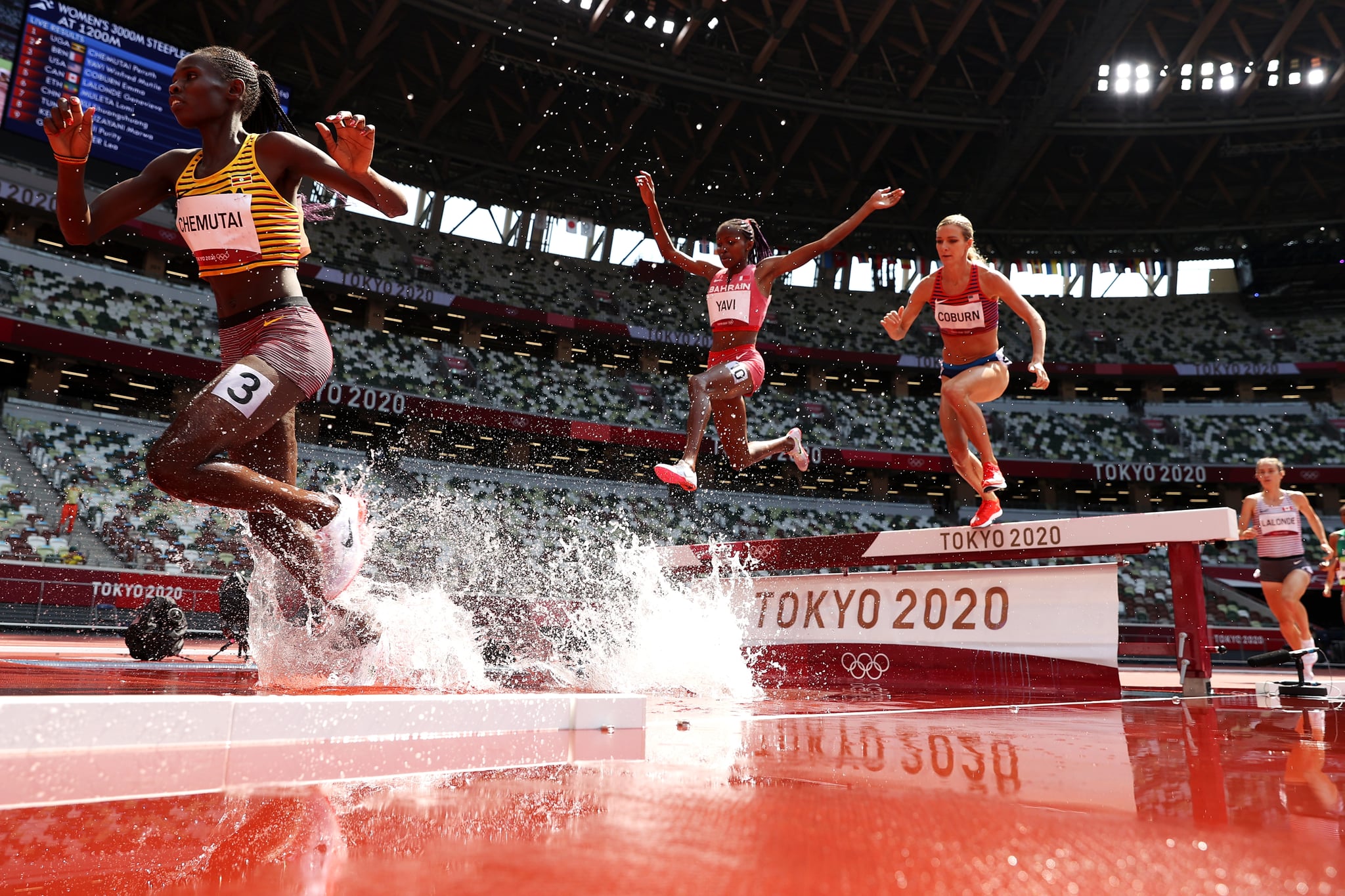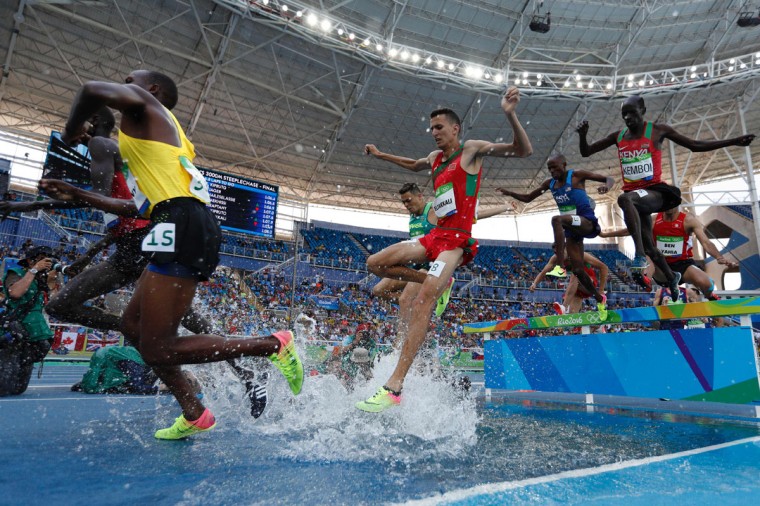History and Evolution of Steeplechase in the Olympics: Steeplechase Olympics Fall

The steeplechase, a grueling endurance race that combines running and obstacle-clearing, has been a staple of the Olympic Games since 1900. Its evolution reflects the changing landscape of athletics, from its early origins as a test of grit and determination to its current status as a highly specialized and strategic event.
Early Years and Development
The steeplechase traces its roots back to the 19th century, when British military officers would race across the countryside, jumping over obstacles like fences and ditches. This tradition eventually evolved into a formal sport, with the first official steeplechase race taking place in 1839 at the Grand National Hunt in England.
The inclusion of the steeplechase in the 1900 Paris Olympics marked its debut on the world stage. The event was initially contested over a distance of 2,500 meters, with obstacles consisting of hurdles and water jumps. The first Olympic steeplechase champion was George Orton of Canada, who set a winning time of 7 minutes and 34 seconds.
Significant Moments and Notable Athletes
- In 1908, the steeplechase distance was standardized to 3,000 meters, a distance that has remained unchanged to this day. This change aimed to establish a more consistent and challenging test of endurance.
- The 1920s witnessed the emergence of legendary steeplechasers like Ville Ritola of Finland, who won two Olympic gold medals in the event and set a world record of 9 minutes and 2.4 seconds. Ritola’s dominance established the steeplechase as a true test of athletic prowess.
- In the 1950s, the development of new training techniques and improved footwear led to significant improvements in steeplechase times. Athletes like Chris Brasher of Great Britain and Vladimir Kuts of the Soviet Union pushed the limits of the event, setting new world records and establishing a new era of speed and efficiency.
- The 1980s and 1990s saw the rise of Kenyan steeplechasers, who dominated the event with their remarkable endurance and natural talent. Athletes like Julius Kariuki, Moses Kiptanui, and Bernard Barmasai set a string of world records and won numerous Olympic medals, solidifying Kenya’s dominance in the steeplechase.
Changes in Rules, Techniques, and Equipment
The steeplechase has undergone several changes in its rules, techniques, and equipment over the years.
- The height and spacing of the hurdles have been adjusted over time to optimize the event’s difficulty and flow. Early hurdles were often taller and more closely spaced, leading to a more challenging and less efficient race. Modern hurdles are lower and more widely spaced, allowing athletes to clear them more easily and maintain their speed.
- The water jump has also evolved over time. In the early years, athletes had to jump over a single, wide ditch filled with water. Today, the water jump consists of two smaller ditches, with a narrow channel in between. This change allows athletes to maintain their speed and momentum while clearing the obstacle.
- The introduction of specialized steeplechase shoes in the 1970s revolutionized the event. These shoes, featuring spiked soles and a lightweight design, provided athletes with better traction and support, allowing them to run faster and jump higher.
Comparing Early and Modern Steeplechase
The steeplechase in the early Olympics differed significantly from the modern event.
- The early steeplechase was often a more chaotic and unpredictable race, with athletes struggling to navigate the obstacles and maintain their speed. The lack of specialized training and equipment made it a test of raw athleticism and determination.
- Modern steeplechase is a highly technical and strategic event, with athletes using sophisticated training methods and equipment to optimize their performance. The focus on speed, efficiency, and obstacle-clearing techniques has made the event more refined and predictable.
Key Elements and Challenges of Steeplechase

The steeplechase, a unique and demanding event in athletics, combines the endurance of long-distance running with the technical challenges of hurdling and water jumping. This blend of elements sets it apart from other running disciplines, requiring a specific set of physical and mental attributes for success.
Technical Aspects of Steeplechase, Steeplechase olympics fall
The technical aspects of steeplechase play a crucial role in determining an athlete’s performance. The water jump, hurdles, and pacing strategies are key elements that athletes must master.
Water Jump
The water jump is a defining feature of the steeplechase, requiring athletes to leap over a barrier and land in a pool of water. The water jump is typically 36.6 meters (120 feet) long and features a barrier that is 3.66 meters (12 feet) wide and 91.4 centimeters (36 inches) high.
The water jump presents unique challenges, including the need to maintain momentum and balance while leaping over the barrier and landing in the water. Athletes must also be mindful of the water’s depth and temperature, which can affect their performance.
Hurdles
Steeplechase hurdles are higher than those used in other running events, measuring 91.4 centimeters (36 inches) high. The hurdles are spaced 35 meters (115 feet) apart, and athletes must clear them without slowing down.
The hurdles require athletes to develop a powerful and efficient hurdling technique, which involves a combination of speed, agility, and coordination.
Pacing Strategies
Pacing is crucial in steeplechase, as athletes must balance their efforts over a long distance while maintaining their speed and technical proficiency.
The most common pacing strategy is to start conservatively and gradually increase the pace as the race progresses. Athletes must also be mindful of the water jump and hurdles, adjusting their pace accordingly.
Physical and Mental Attributes for Success
Steeplechase demands a unique blend of physical and mental attributes for success. Athletes must possess:
- Endurance: The long distance of the race requires exceptional cardiovascular fitness and the ability to sustain a high level of effort for an extended period.
- Speed: While endurance is essential, athletes must also be able to maintain a fast pace, especially over the hurdles and water jump.
- Strength: The water jump and hurdles require considerable strength and power, particularly in the legs and core.
- Agility: The hurdles and water jump demand agility and coordination, enabling athletes to quickly change direction and maintain balance.
- Mental Toughness: The physical and technical challenges of steeplechase require mental resilience, focus, and the ability to handle pressure.
Iconic Moments in Olympic Steeplechase
The Olympic steeplechase has witnessed numerous iconic moments, showcasing the challenges and triumphs of athletes.
“The steeplechase is a race of attrition, where the strongest and most determined athletes prevail.” – Steve Cram, former Olympic steeplechaser
Examples of Iconic Moments
- 1984 Los Angeles Olympics: Julius Korir of Kenya, known for his aggressive running style, won the gold medal in a thrilling finish, setting a new Olympic record.
- 2000 Sydney Olympics: The 2000 Sydney Olympics saw a close finish between Reuben Kosgei of Kenya and Saif Saaeed Shaheen (formerly Stephen Cherono) of Qatar. Shaheen ultimately won the race in a photo finish, setting a new world record.
- 2012 London Olympics: Ezekiel Kemboi of Kenya won his second consecutive Olympic gold medal, demonstrating his dominance in the event.
Steeplechase olympics fall – The steeplechase, a demanding event in the Olympics, involves navigating hurdles and a water jump, which can lead to dramatic falls. One such fall, which captured the attention of many, involved Girma Gemechu, a rising Ethiopian athlete. Girma’s steeplechase fall became a case study in the risks and resilience inherent in the sport.
While falls are common in steeplechase, Girma’s experience highlighted the importance of mental fortitude and the ability to overcome setbacks in pursuit of athletic excellence.
The steeplechase, with its demanding obstacles and grueling pace, is a test of both physical and mental fortitude. A fall during the race can be a devastating setback, but the ability to recover quickly is crucial. Similarly, finding a used leather sofa and chair can be a rewarding experience, but it requires careful consideration and evaluation to ensure a good purchase.
This guide can help you navigate the process of finding the perfect piece. Just as a steeplechase runner must stay focused and adapt to unexpected challenges, a buyer of used leather furniture needs to be prepared for potential issues and be ready to make informed decisions.